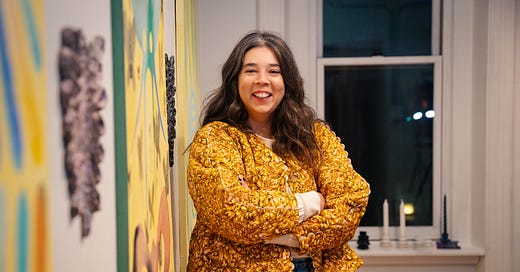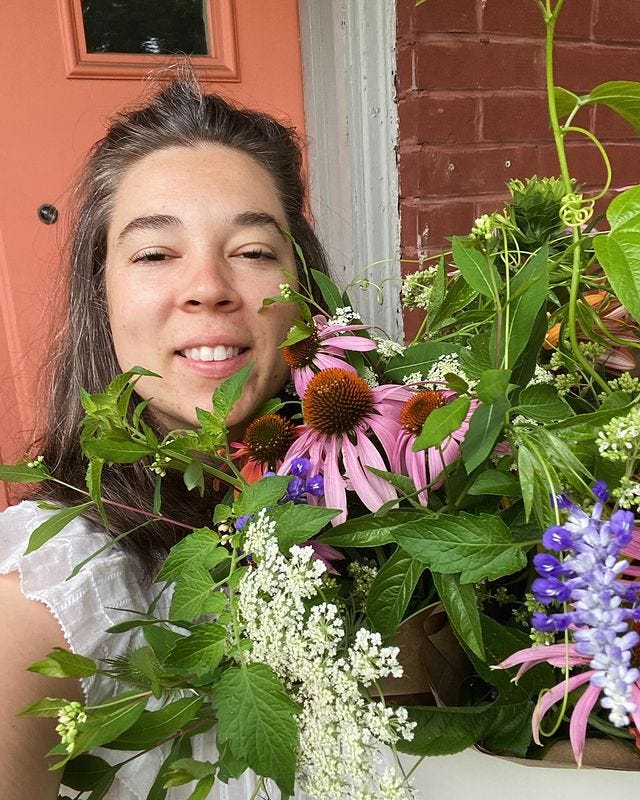Interview No. 5: Jessie Rommelt, Bunker Projects
Talking to the creative director and co-founder of one of Pittsburgh's raddest galleries. "I love stewarding a place that gets imprinted with so many people’s energy," she says.
Pittsburgh’s Bunker Projects is one of the coolest art spaces I’ve ever been to. Opening its bright-green door and climbing the stairs to the second-floor gallery feels like entering a secret portal; step through it and you’ll be greeted by thought-provoking, world-class exhibits and get a glimpse of works in progress by the gallery’s artists in residence, who live and work on-site.
Jessie Rommelt, Bunker Projects’ creative director, is the gallery’s beating heart. A Penn State grad with a background in sculpture and art history, she moved to Pittsburgh after graduation and worked as a framer and personal assistant before co-founding Bunker Projects in 2012 with two friends from PSU.
Today, Bunker Projects is an inclusive, experimental gallery and workspace where artists can produce and show work and build community; it’s also a nonprofit that’s funded by grants, community partnerships and individual donations. And this year, 12 years after the the gallery was born, Rommelt was able to purchase Bunker’s building from the Bloomfield Garfield Corporation, cementing its future for years to come. To buy the property, she launched a capital campaign through DonorBox that raised more than $50,000 from 698 individual donations and helped secure an affordable mortgage.
Talking to Rommelt, it’s clear that her business brain is just as sharp as her artist’s sensibility, and that she’s the perfect person to lead Bunker Projects into the future. Click here to learn about the gallery’s current exhibition and read on for more of my conversation with Rommelt, which has been edited for length and clarity.
Name: Jessie Rommelt
Age: 35
Zodiac sign: Leo
Were you into art as a kid?
“Yeah. I remember doing ceramics and having a kind of wandering, playful response to art.”
What was the draw of moving to Pittsburgh after you graduated from Penn State?
“Well, were coming from central PA, and by that time, New York and Philadelphia had gotten pretty expensive. And we knew from older siblings that this was a cool city.”
What made you decide to open Bunker Projects?
“I’d been interested in place-making in galleries, and how a gallery could be activated beyond just the presentation [of art]. I was interested in residency spaces, too.
“So I had my eyes open, and I was attending Bloomfield Garfield Corporation's monthly community meetings at the time. I rolled up to a meeting and one of the other gallery owners said, ‘They're looking for somebody to take over the upstairs apartment in the Mr. Roboto building [where the first floor is a music venue].
“Plus, the guiding principles for the neighborhood were to engage artists and rely on them to reactivate spaces that had been discarded. We lucked into this spot and have a very supportive relationship with the Bloomfield Garfield Corporation, which owned it.”
How did you get the space up and running?
“I was in my early 20s and had this amazing support system with my friends. We were very hands-on, thanks to our sculpture backgrounds—like, ‘We know how to use power tools! I think we can fix a lot of this space!’ We got help, of course, but we did a lot ourselves. And we soon realized that [the neighborhood] has a First Friday art walk, which is a long-standing tradition that brings people to the neighborhood. I was like, ‘Wow, we really ended up in the right place.’
“There was also a graduated period where rent was free for three years, then we paid $300 per month, then $500, then $700.”
What led to being able to buy the building?
“Bloomfield Garfield Corporation has a long history of working with us and wanted to make the building available for us to purchase. We always knew that we were going to get first right of refusal [when they decided to sell], and last summer, they decided they wanted to, and wanted to move on it quickly. We had to press the gas pedal, which was a little stressful at first because there hadn’t been any recent indication [the sale] was going to happen. So beginning last summer, we laid the groundwork for purchasing the building. That’s been the last nine months!”
Wow.
“Yeah. We were doing all of our programming and simultaneously tackling this high-stakes challenge and fundraising to buy the building.
“It was very much, like, ‘OK, you need to make this happen.’ I was so profoundly relieved when we signed the papers and it was all done. I felt alive!’”
Share more about how you work with artists-in-residence, who live on-site and develop their work as part of your free residency program.
“We’re starting a relationship that’s deepening as they're here, and we ask, ‘Where do we want to end up?’ I try to have very real, graduating relationships with people. I don't ever want to dive into the deep end and end up in a stressful environment. Our rhythm—the residency and exhibitions—is very real.
“We actually have three artists-in-residence here right now. We sometimes work with returning artists, who will do a show.”
What’s your favorite part of what you do?
“I love being in the studio and connecting with artists, especially when they can be here over a period of time. I love what you come to understand [about people] by interacting with them over time.
“I also love stewarding a place that gets imprinted with so many people’s energy. I try to be grateful because a lot of people don't get the chance or have the time to have deep, interpersonal conversations with people. They don't get to connect.”
What’s the best thing about owning a business in Pittsburgh?
“There are a lot of people who live and work within this neighborhood or the neighborhoods that scoot right up against it. Because of that, we’re like a village. We know the other business owners, and we really like to welcome the neighbors who come out to First Friday, our most-circulated open house environment.
“I think we all want even more of that [First Friday] energy spread across the week. It has been a lot more busy here in the last year or two, especially in our section of Penn Avenue, but it can still be quiet. I'm always thinking about the kinds of other small businesses that we need that would make life even easier. We just got a bakery, finally!”
What other kinds of businesses would you like to see?
“Maybe a diner. A print shop. A dry cleaner. The classics.”
What’s been the most challenging thing about owning a business here?
“Dealing with the capitalism and financial plans—but we've found ways in. Having a thrifty, compact set of expenses been one of our leading approaches to business, on top of the fact that we've partnered with people who want to see us succeed and we’ve kept our overhead low from the very beginning.
“Negotiating the ideals of wanting to invest in the many artists we work with and the many programs that we do in a big way—while also having to be really practical—is challenging. Historically, a lot of the leaders here [in Bloomfield-Garfield] have been either working-class or a regular-ass person, like me, in contrast to some people working in arts and culture who have generational wealth that’s driving what they do. The logistics of what is possible both financially and in terms of our business is a central concern of the arts.”
Do you think you would be able to open Bunker Projects today?
“I don’t know. Honestly, it might be a 50-50 situation. But the vacancy and financials in 2012 were very different. This area was more of an under-utilized, under-imagined Main Street."
What are your goals for the future?
“I would like to add to our staff. I’d like to increase the amount of money we’re able to allocate to artists as a stipend and for production. We make sure that we pay artists $500 as, honestly, a symbolic acknowledgement—a way of saying, ‘You’re coming in as an indispensable part of this exhibition. What you do is professional and integral.’"
Talk a little about the events that you do here.
“It's been a slow journey back into doing events since Covid, and I'm still rethinking how I want to implement them. What is an environment that's actually going to allow us to have more authentic interactions?”
You also have a flower business (@jessieandtheblooms). How did that start?
“I've liked to garden and I've been playing and learning for quite a while, but then I started to realize, ‘I can bring some of my approaches—like, building spaces and community—to gardening.’ It became my own creative practice. I’ve been doing it seriously for five or six years.”
What do you love about gardening?
“It gives me a lot of balance—and counter-balance—to being so closely identified with Bunker Projects. I don't currently find myself wanting to make art objects, because I'm interacting with so many different works of art every day. So I’m just following my nose into the garden.”
Jessie shares three tips for getting involved in the local art community.
Find art spaces near you. “Find the art spaces in your neighborhood and follow them on social media and join their email lists. Also check out Visual Arts Coalition for Equity (VACE) for an awesome selection of visual arts spaces that collaborate and organize together. When you see upcoming programming featuring artists, check out their personal/art pages. You can often follow along with some really great behind-the-scenes preparations leading up to the actual exhibition.”
Explore. “Explore spaces and venues that intrigue you and you'll find out what you like as you go. Bring a buddy and or a date to get into artsy explorer mode. This is by no means an essential, but I personally recommend asking to meet the director of the gallery and the artist while you're there. You get to connect a bit more, ask questions or just congratulate them and help them feel appreciated. Sometimes art spaces can feel a little formal, but trust me, most of us think about openings and events as a chance to meet and greet people in the community.”
Volunteer. “Once you find some fave spots, check out the volunteer opportunities. Maybe you can offer your services for a project, or get involved in volunteer days. It's a great way to meet people and you never know where it will take you.”







